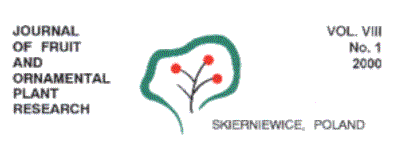VOL. VIII No. 1 2000

Danuta Wawrzyńczak, Iwona Sowik, Lech Michalczuk
Research Institute of Pomology and Floriculture
Skierniewice, POLAND
AGROBACTERIUM-WEDIATED TRANSFORMATION OF FIVE STRAWBERRY GENOTYPES
ABSTRACT. Transgenic plants of five strawberry genotypes (Fragaria x ananassa Duch.) were obtained by Agrobacterium-mediated transformation of leaf explants taken from in vitro shoots or greenhouse-grown plants. Transgenic shoots of 'Elsanta', 'Kaster' and two clones: K-1349 and K-1476 were regenerated on a medium composed of MS (Murashige and Skoog's) basal medium and vitamins with 3% sucrose, 500 mg l-1 casein hydrolysate, 1.5 mg l-1indolilo-3-butyric acid (IBA). 'Senga Sengana' transgenic plants were obtained on a medium consisted of MS basal salts, Gamborg's B5 vitamins, 3% sucrose, 500 mg l-1 casein hydrolysate, 4.0 mg l-1 BA and 0.25 mg l-1 IBA. Transformation efficiency in different genotypes varied and was the highest for 'Senga Sengana' (5.71%) and the lowest for K-1349 clone (1.67%). All transgenic shoots obtained formed roots in the presence of 25 mg/l kanamycin and then were successfully acclimatised in a greenhouse. The incorporation of the transgene was confirmed by PCR with gus-specific primers and its expression by the histochemical assay of b -glucuronidase activity. The growth and morphology of transgenic plants did not differ as compared to those of not transformed, which proves that the regeneration and selection protocol did not induce any significant variation. benzyladenine (BA) and 0.1 mg l-1
Key words: regeneration, strawberry, tissue culture, genetic transformation
Anna Pobudkiewicz
Research Institute of Pomology and Floriculture
Skierniewice, POLAND
CONTROLLING THE GROWTH HABIT OF Streptocarpus hybridus WITH FLURPRIMIDOL
ABSTRACT. The experiment was conducted to improve the habit of Streptocarpus hybridus 'Pink Nana' and 'Blue Nana' using flurprimidol. Rooted cuttings of streptocarpus were planted into 10 cm pots containing a medium composed of sphagnum peat: perlite (3:1, v/v). Growth retardant was applied as a single spray at concentrations of 6,12 and 18 mg l-1, when plants had developed 2 or 5 leaves. A good habit of streptocarpus 'Pink Nana' and 'Blue Nana' was obtained, when plants with 2 leaves (4-6 cm in length) were treated with flurprimidol at 12 mg l-1. As compared with the control plants, the peduncle length, leaf length, floret diameter, number of peduncles or florets of flurprimidol-treated plants were significantly smaller. On such plants intensified leaf colour was observed.
The chemical name used: a-(1methylethyl)-a-[4-(trifluoromethoxy)-phenyl]-5-pyrimidinemethanol.
Key words: streptocarpus, pot plant, growth control, flurprimidol, growth retardant
Alojzy Czynczyk
Research Institute of Pomology and Floriculture
Skierniewice, POLAND
GROWTH AND FRUITING OF TWO APPLE CULTIVARS REPLANTED AT VARIOUS DENSITIES OVER AN OLD APPLE ORCHARD
ABSTRACT. Apple trees cvs Lobo and Lodel grafted on P 22, M.9, P 2, P 60, M.26, P 14 and P 1 rootstocks were planted at various densities at a site where orchards were grown for the past 70 years. Growth vigour of the trees and fruit yield were relatively low, which may indicate the occurrence of replanting syndrome. Tree size enhanced with an increase of distance between trees and fruit yield per tree was generally proportional to tree size. Yielding efficiency was much higher for small trees. A highest cumulative yield per hectare was obtained from trees planted at the highest density.
Key words: cultivar, rootstock, replanting, densities, growth, fruiting
Carlos R. Wlosek-Stangret, Ewa Jadczuk
Warsaw Agricultural University, POLAND
GROWTH AND FRUITING OF 'JONAGOLD' APPLE TREE AS AFFECTED BY A ROOTSTOCK
ABSTRACT. 'Jonagold' apple trees on eight rootstocks: M.26 of English selection, M,9 sub-clones 751 and 984 selected in Germany and P 14, P 16, P 2, P 22 and P 60 of Polish selection were planted on fertile, silty loam alluvial soil in an experimental orchard of the Department of Pomology, Warsaw Agricultural University in Warsaw-Wilanów in the spring of 1991. Trunk diameter was measured 2,4,6 and 8 years after planting. Growth vigour, expressed as trunk cross-sectional area (TCSA) increment, was the lowest for trees grafted on P 22 and the highest for those on P 14. The cropping efficiency index expressed as a ratio of the total commercial yield to TCSA was the highest for trees on P 22 and the lowest for those grafted on the most vigorous rootstock P 14.
Key words: apple, 'Jonagold', rootstock, age, growth, cropping
Mariusz Lewandowski, Edward Żurawicz
Research Institute of Pomology and Floriculture Skierniewice, POLAND
SHORTENING THE JUVENILE PERIOD IN APPLE SEEDLINGS BY GRAFTING ON P 22 DWARFING ROOTSTOCK
ABSTRACT. The uppermost parts of dormant main shoots of 2-year-old apple seedlings, grown outdoors, were hand grafted on P 22 rootstocks. The grafted trees were planted into 8-litre containers filled with a 1:1 mixture of soil substrate and plant compost. Then they were grown under plastic cover, until transplanting at the end of August to a permanent site. The seedlings, from which the tips were used for grafting, were transplanted to the same site a few months earlier, at the end of April. Some 30 percent of grafted seedlings bloomed in the second year after grafting and additional 40 percent a year later. None of the original rooted seedlings developed flower buds during that period.
Key words: apple breeding, juvenile period, rootstock
Emilian Pitera
Warsaw Agricultural University, POLAND
SUITABILITY OF THREE POLISH SCAB-RESISTANT APPLE CULTIVARS FOR CULTIVATION UNDER LIMITED FUNGICIDE USE
ABSTRACT. Tree growth, productivity, healthiness and fruit quality of three scab-resistant apple cultivars Witos, Sawa and U 184 (formerly 'Alka') bred at the Department of Pomology, Warsaw Agricultural University, were evaluated during 1994-1999. For comparison the scab-resistant cultivar Freedom of American breed carrying Vf gene, cultivar Lodel with low susceptibility bred at the Research Institute of Pomology and Floriculture, Skierniewice and the susceptible cultivar Delicates were used. Ali trees on M.9 rootstock were planted in the autumn of 1992. Fungicides were used only against powdery mildew. During seven years no symptoms on scab-resistant cultivars had been obsen/ed, while leafs and fruits of 'Delikates' were infected. In 1999, symptoms of sooty blotch on some fruits of 'Freedom' and 'Lodel' were noted. Considering the scab-resistance, yield of trees and fruit size, appearance, juiciness and flavour, 'Sawa' seems to be a promising autumn apple cultivar for commercial orchards, especially for integrated and ecological fruit production. The other two 'Witos' and 'U 184' are also suitable for this type of orchard but on a limited scale. 'U 184' can be used as a pollinator for 'Sawa'.
Key word: apple cultivars, scab-resistance, minimum use of fungicides, productivity, fruit quality
INSTYTUT OGRODNICTWA – PAŃSTWOWY INSTYTUT BADAWCZY
Siedziba Dyrekcji
ul. Konstytucji 3 Maja 1/3
96-100 Skierniewice
Tel.: 46 833 22 11 do 13 - Centrala
Fax: 46 833 31 86
e-mail: io@inhort.pl
ul. Pomologiczna 18
96-100 Skierniewice
Tel.: 46 833 20 21 - Centrala, 46 833 42 23 - Centrala
Fax: 46 833 32 28
ZAKŁAD PSZCZELNICTWA
W PUŁAWACH
ul. Kazimierska 2A
24-100 Puławy
Tel.: 81 886 42 08, 81 886 21 64
Fax: 81 886 42 09
e-mail:zaklad.pszczelnictwa@inhort.pl
© Copyright 2011 Instytut Ogrodnictwa, wszystkie prawa zastrzeżone / Kontakt: < Redaktor > < Webmaster >


